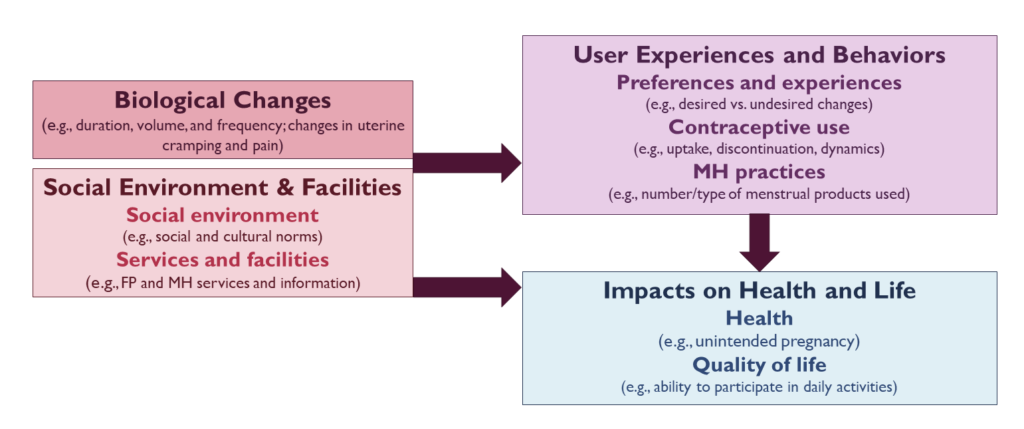Introduction
Despite the wide-ranging impact of CIMCs, little attention and funding have been dedicated to thoroughly studying and measuring their side effects and to supporting the integration of family planning and menstrual health services and programming.
In this blog post, I share the process of developing a CIMC measurement framework by a global group of family planning and menstrual health experts who came together to develop a CIMC Global Research and Learning Agenda (RLA), which provides guidance to researchers, product developers, health care providers, program implementers, advocates, policymakers, and funders to conduct research and implement strategies to address CIMCs, here. The development of this measurement framework was an evidence-informed and collaborative process that evolved organically.
The CIMC measurement framework
A key component of the CIMC RLA is the measurement framework (Figure 1) that underpins every other component of the RLA.
The directions of influence, outlined by the arrows, show the relationship between one domain and the other. For example, biological changes experienced by an individual and the environment within which they are based influence their experiences and behaviors related to CIMCs, and so forth.
Methods: Development of a CIMC measurement framework
It began in November 2020 when FHI 360 hosted a virtual technical consultation on the topic of CIMCs, which brought together more than 200 family planning, menstrual health, and reproductive health experts from 39 different countries. Several hours of this two-day consultation were dedicated to the topic of measurement and, in preparation for the technical consultation gathering, speakers and meeting organizers did a rapid review of the literature, examining both the overall scope of the problem and common methods and tools used to measure this issue.
Literature Rapid Review
The literature review was eventually developed into an annotated bibliography, which is available here.
One of the first things that became evident during this review of the literature is that the issue of CIMCs is multifaceted. One publication in particular brought this to light: There might be blood: a scoping review on women’s responses to contraceptive-induced menstrual bleeding changes by Polis et al., which is the only literature review to ever be published on the topic of CIMCs.
Another aspect of the evidence that became clear during the rapid review is that family planning and menstrual health research are very separate from one another in practice. Nonetheless, there are findings from both that are integrated into the RLA and the framework. For example, literature published in the family planning field looks at the impact of CIMCs on switching and discontinuing contraception, which impacts health outcomes; while literature from the menstrual health field looks at menstrual practices like facility access and product use, which impacts quality of life. All these aspects were important to include in the CIMC measurement framework.
Building Consensus in Framework Development
Once a draft of the framework was developed based on the rapid literature review and categorization, it was presented during the technical consultation and then examined in-depth during the event’s small group discussions.
Following the technical consultation, FHI 360 convened a CIMC Task Force to synthesize the content of the technical consultation and continue to promote research and work related to CIMCs. This Task Force is made up of 28 members from 10 countries, including those with expertise in family planning and menstrual health measurement. The group decided to move forward with developing an RLA and thought it best to divide and conquer, organizing themselves into subcommittees around key topics of interest.
As a part of this work, the measurement subcommittee was tasked with updating the CIMC measurement framework based on feedback from the technical consultation. This small group of experts worked together to consider and carefully incorporate all feedback and improve the new framework using their own expertise. Once a new draft was completed, this and the other components of the RLA were sent out for wide community review. This process garnered feedback from 32 people at 23 organizations across 10 countries. The Task Force also reached out to specific experts for more targeted review, and this included three measurement experts from Performance Monitoring for Action. Once feedback from experts and the community was incorporated into the framework it was then disseminated during a virtual launch event attended by 168 participants in November 2021.
Putting the framework into action
The CIMC RLA calls on involved stakeholders to use the CIMC measurement framework as a starting point under which evaluations and indicators can be organized to ensure that CIMC research and programs are comprehensive. Further work is needed, particularly in the area of measuring CIMCs, including a need to compile and review current indicators and tools being used across disciplines, to measure CIMCs at all levels and identify gaps and areas for opportunity and standardization.
Our team is currently putting the CIMC measurement framework into action as we work to develop a full monitoring plan for CIMC programs. Now that the measurement framework is complete and available, we hope that other researchers and program implementors use it to guide their own work related to CIMCs as well. Please report these experiences and direct all inquiries about this framework to Emily Hoppes, ehoppes@fhi360.org.





